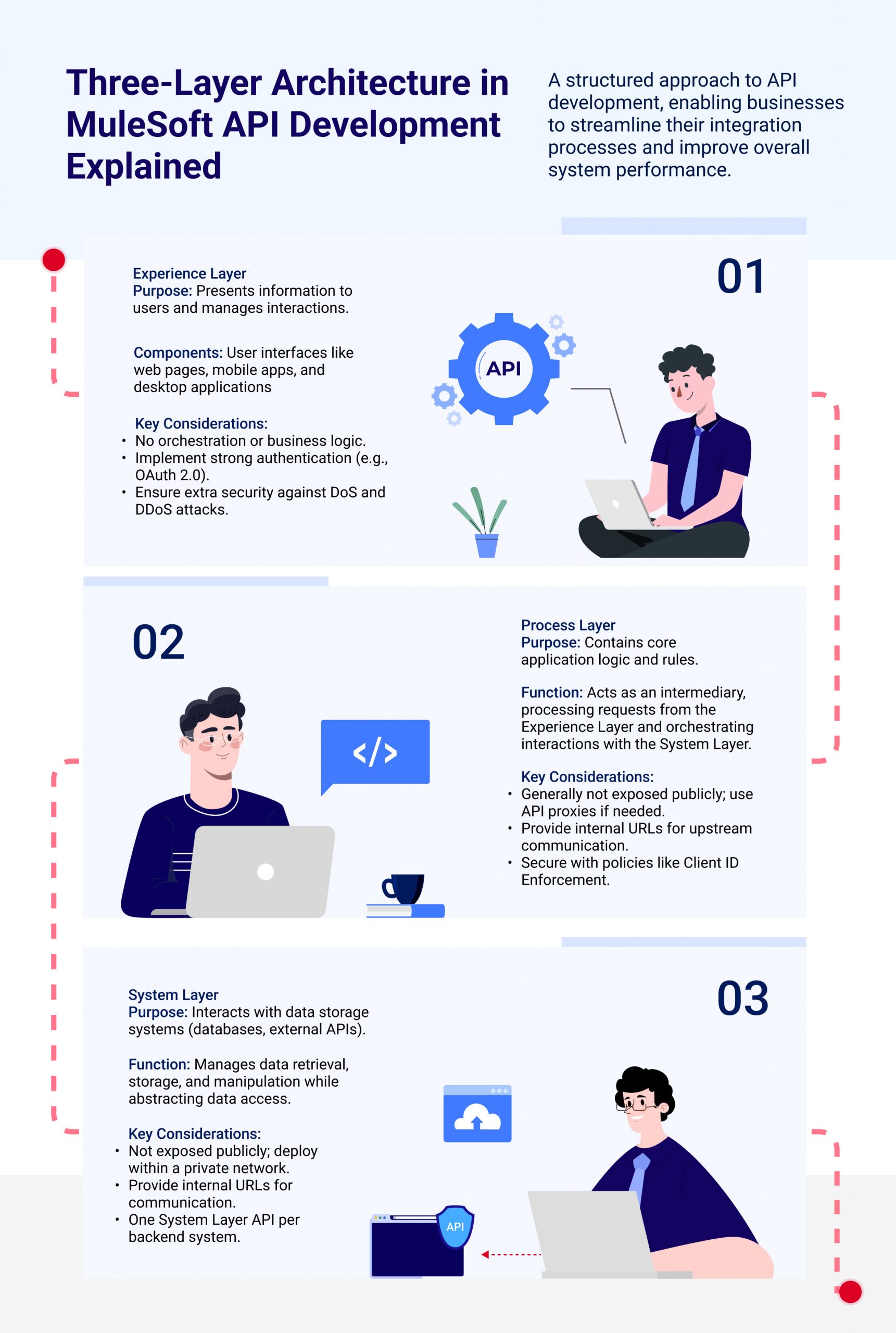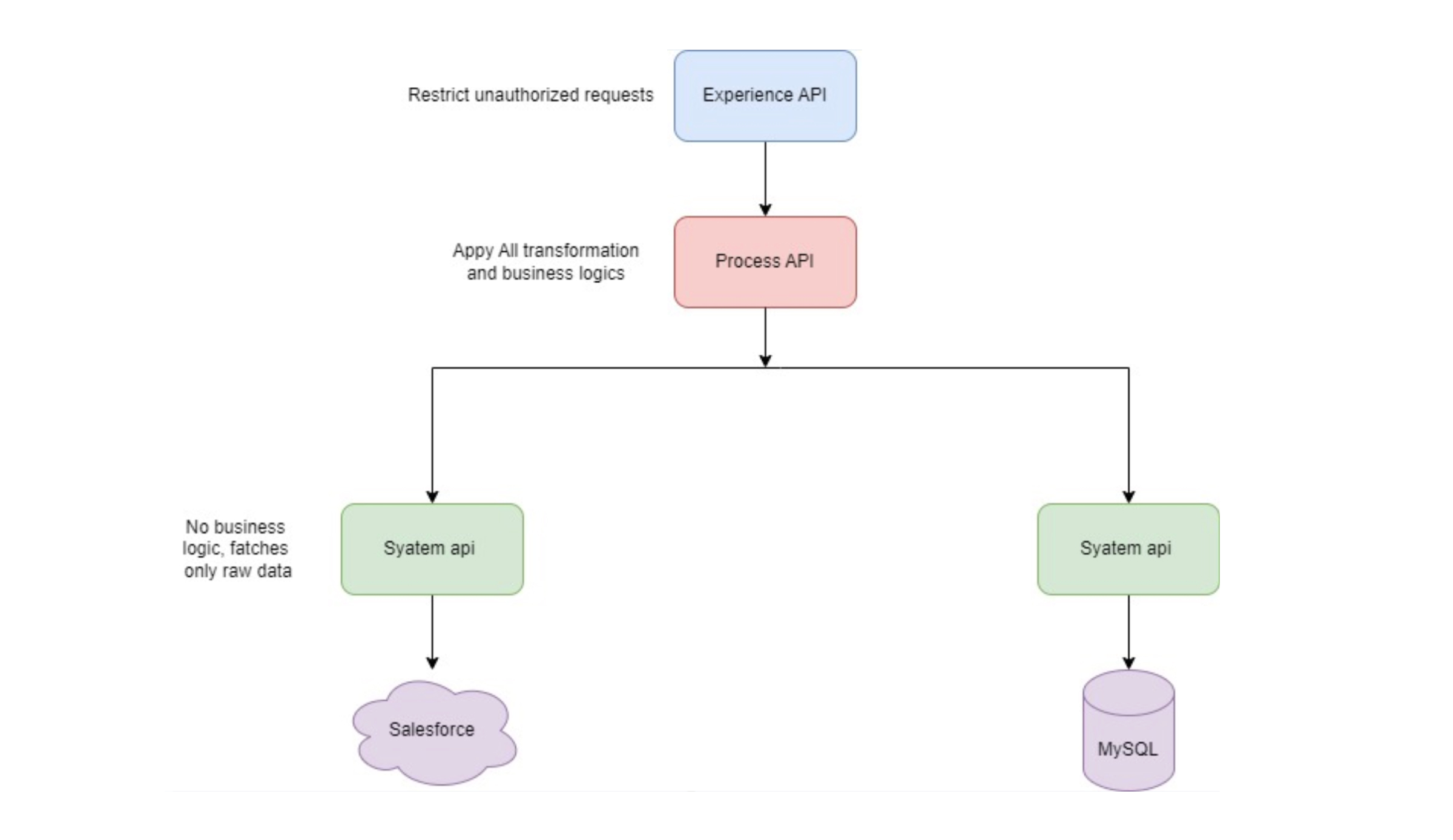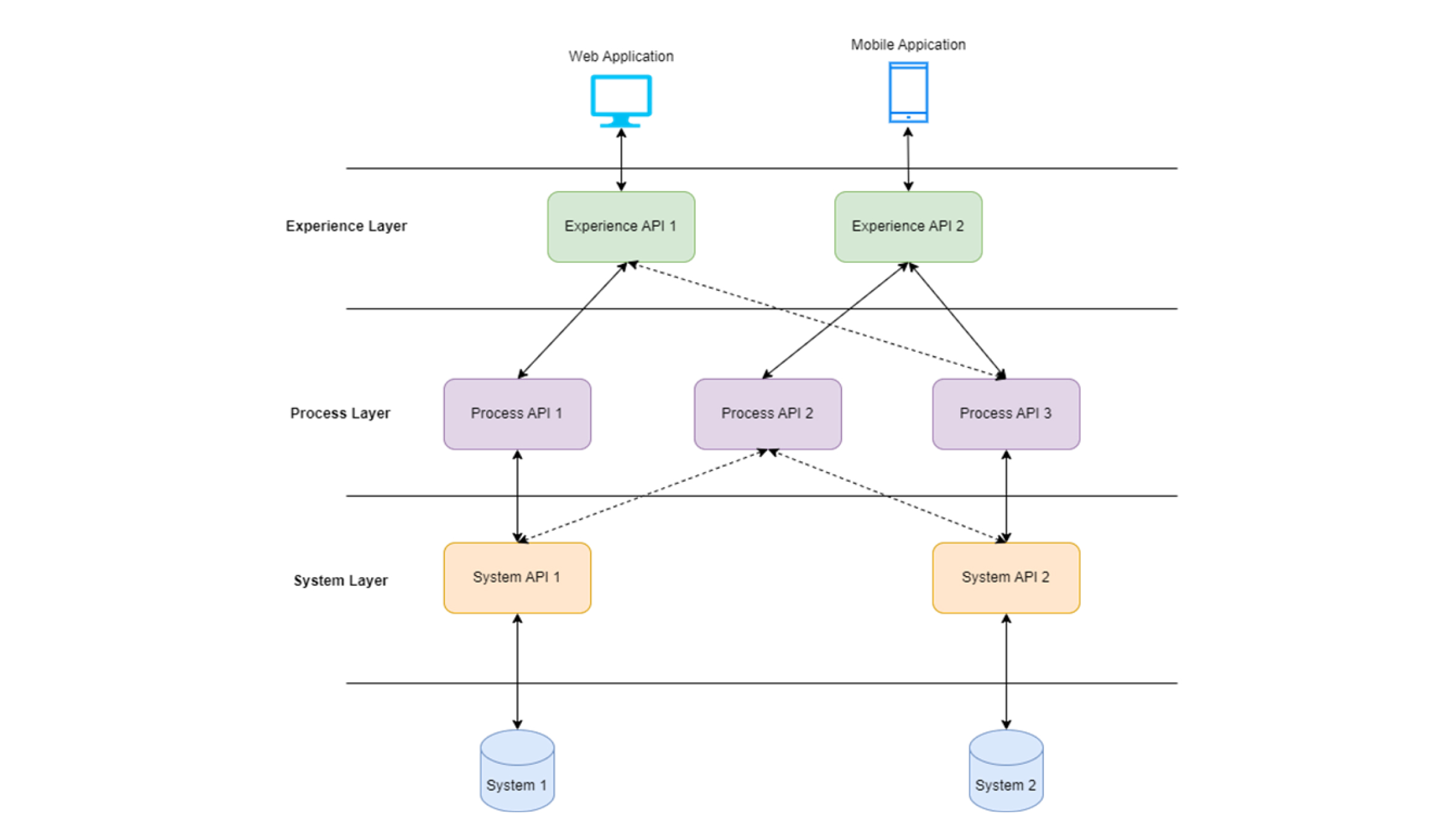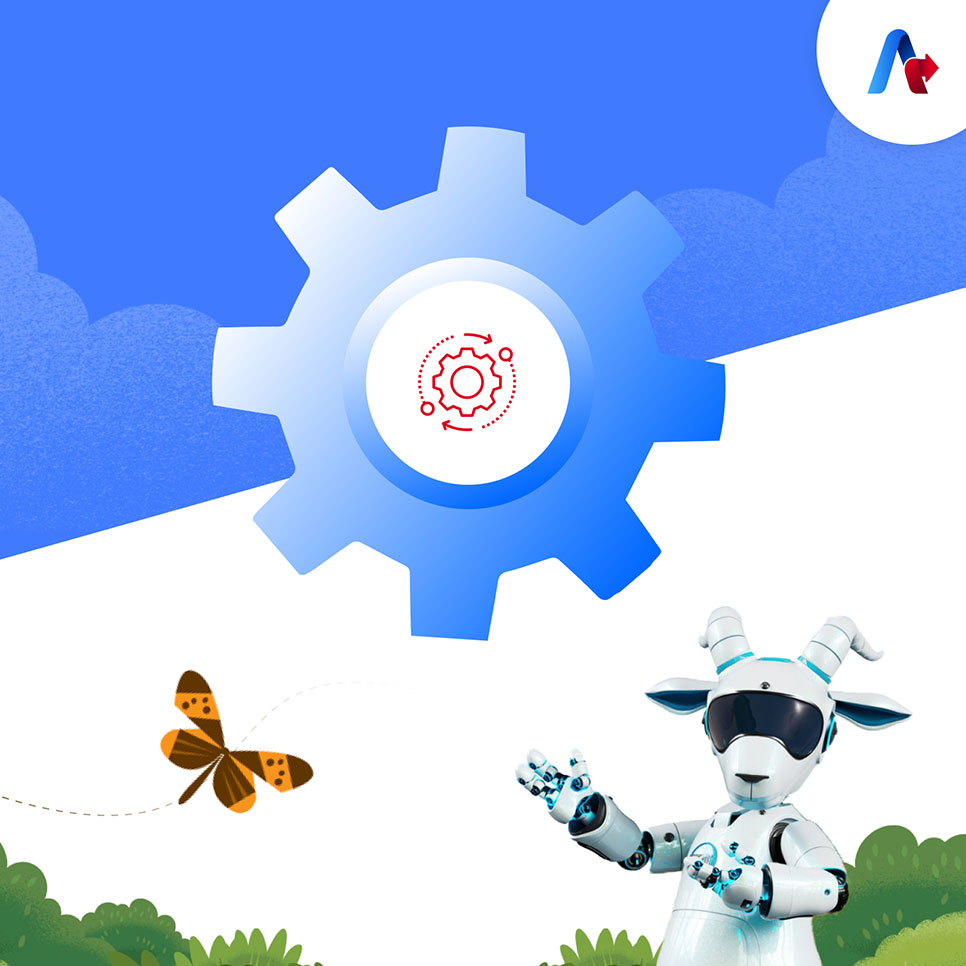API Led Connectivity
BLOG
Before we dive in, let’s talk about why reusability is so important. In a growing business landscape, service providers often struggle to keep up with rising demands. They typically face two choices: hire more staff, which can drive up costs without necessarily improving results, or take a smarter approach by creating reusable assets that adapt to changing needs. This second option not only fills market gaps but also enhances agility and cost-effectiveness.
MuleSoft comes with a powerful solution to promote reusability through its innovative strategy known as MuleSoft API-Led Connectivity. This approach allows enterprises to build on existing assets, making it easier to respond to market demands while maximizing efficiency. In this blog, we will explore how API-Led Connectivity architecture works and the benefits it offers for your business.
Facing challenges with application reusability?
Let’s Discuss!Understanding the Three-Layer Architecture of API-Led Connectivity
API-Led Connectivity is an architectural methodology that helps create applications that are inherently more organized, manageable, and comprehensible. This approach breaks down applications into three distinct layers, making them easier to understand and maintain.
In this blog, we will learn about the practical implementation of the three-layer architecture in MuleSoft API development. We will explore each layer in detail, discuss their components, advantages, and real-world applications. Within the MuleSoft ecosystem, this architectural paradigm is commonly known as API-Led Connectivity. Let’s get started!

The Three Layers of API-Led Connectivity
API-Led Connectivity breaks down an application into three interconnected layers: the Experience Layer, Process Layer, and System Layer. These layers work together to facilitate the movement of requests and responses between source and target systems in both directions.
Experience Layer
The Experience Layer is responsible for presenting information to users and handling their interactions. It typically consists of user interfaces like web pages, mobile apps, or desktop applications. The primary goal of this layer is to provide a user-friendly interface for interacting with the application. In the MuleSoft ecosystem, the Experience Layer focuses on exposing APIs to external consumers.
Her is a list of things that needs to be taken care while designing the Experience Layer API’s:
- Experience Layer must be not responsible for orchestration, routing or any business logic.
- This Layer must be enabled with strong Authentication and Authorization like OAuth 2.0.
- Experience Layer must have extra security to avoid DoS, DDoS or any API attacks.
Process Layer
The Process Layer contains the core logic and rules of the application. It acts as an intermediary between the Experience Layer and the System Layer, processing requests from the Experience Layer, executing business rules, and orchestrating interactions with the System Layer. This layer ensures that the business logic remains independent of the user interface and data storage mechanisms.
Here is a list of things that needs to be taken care while designing the Process Layer API’s:
- Process Layer generally is not exposed publicly, and it should be deployed within a private network or private port. In case, if you want to expose Process API to consumers, you can create API Proxy on top of Process API and ask consumers to connect through API Proxy. In this way, we can stop exposing Process API implementation directly.
- Always provide an internal URL to upstream internal API to communicate with Process APIs.
- Process API must be secured by applying security policies like Client Id Enforcement Policies.
System Layer
The System Layer is responsible for interacting with the underlying data storage systems, such as databases or external APIs. It handles tasks related to data retrieval, storage, and manipulation. By abstracting the data access logic into a separate layer, the rest of the application remains unaware of the specific data storage implementation, promoting modularity and maintainability.
This layer encompasses connectors, reusable API fragments, and integration with various protocols and data formats.
Here is a list of things that needs to be taken care while designing the System Layer API’s:
- System Layer API generally not exposed publicly, and it should be deployed within a private network or private port.
- Always provide an internal URL to upstream API to communicate with System Layer APIs.
- There must be one System layer API for one backend System.
Benefits of the Three-Layer Architecture in MuleSoft
When we talk about the benefits of the Three-Layer Architecture in MuleSoft, it’s clear that this structured approach offers significant advantages for building and maintaining applications. By organizing applications into distinct layers, MuleSoft enhances reusability, performance, and flexibility, making it easier for teams to develop solutions that meet evolving business needs.
1. Reusability
By segregating concerns into distinct layers, MuleSoft applications become more reusable, which simplifies maintenance and updates. This means that components developed for one project can easily be adapted for future projects, saving time and resources.
2. Performance
MuleSoft applications structured with Three-Layer Architecture can optimize performance by distributing workloads across multiple instances. This efficient distribution allows applications to handle increased traffic and maintain responsiveness, leading to a better user experience.
3. Flexibility
The modular structure of the Three-Layer Architecture provides flexibility in technology selection. Developers can choose the most suitable tools and frameworks for each layer, enabling organizations to leverage the latest technologies and best practices for their specific needs.

Real-World Application of the Three-Layer Architecture in MuleSoft
To understand the practical application of the Three-Layer Architecture in API-Led Connectivity, let’s explore this particular use case that not only helps in structuring APIs effectively but also ensures that they meet the diverse needs of modern applications.
Use Case
In this scenario, the client has specified the need to establish an effective API-led connectivity framework. This involves connecting to various core backend systems, retrieving data from multiple sources, and securely delivering that data to clients. Additionally, the API must ensure security across all layers, as it will serve multiple consumers, including web and mobile applications.
Solution
Based on the client's specifications, we will adopt a three-layer API-led connectivity approach, comprising Experience, Process, and System APIs. The System APIs will directly retrieve data from backend systems such as Salesforce or databases. The Process API will then gather data from these System APIs, facilitating any necessary transformations, mappings, or aggregations before forwarding them to the Experience API. The Experience API will serve as the interface exposed to both mobile and web applications.
This three-layer architecture not only provides scalability, allowing for the addition of more Experience layers in the future while reusing existing Process and System APIs, but also ensures security at each layer through the implementation of API security policies.

Case Study: Home Loan Application Processing through API-Led Connectivity
Best Practices for Implementing Three-Layer Architecture in MuleSoft
When it comes to successfully implementing the Three-Layer Architecture in MuleSoft, following a set of proven best practices can make all the difference. These guidelines help ensure that your APIs are well-designed, maintainable, and deliver maximum value to your organization and its customers.

1. Design-First Approach
Begin your MuleSoft project by focussing on API design and creating better RAML contracts for the Experience Layer before proceeding to implementation. This design-first approach allows you to clearly define the API's structure, endpoints, and expected behavior before diving into implementation. It promotes better collaboration, reduces rework, and ensures that your APIs meet the needs of your consumers.
2. Separation of Concerns
Clearly define the responsibilities of each layer in your Three-Layer Architecture. The Experience Layer should focus on user interaction and API exposure, the Process Layer should handle business logic and orchestration, and the System Layer should manage data access and API led integration. By maintaining this separation of concerns, you can create more modular, maintainable, and scalable applications.
3. Reusable Components
Identify and express the essential features of reusable logic and connectors within the Process and System Layers. This promotes reusability, reduces redundancy, and enables faster development of new APIs. By building upon existing components, you can accelerate time-to-market and ensure consistency across your application portfolio.
4. Error Handling and Logging
Implement robust error handling mechanisms and logging strategies at each layer of your MuleSoft application. This allows for effective troubleshooting and monitoring, making it easier to identify and resolve issues. Consistent error handling also enhances the user experience by providing meaningful feedback when errors occur.
5. Continuous Integration and Deployment (CI/CD)
Embrace CI/CD practices to automate testing, deployment, and versioning of your MuleSoft applications. This ensures rapid and reliable delivery of updates and new features. By setting up a CI/CD pipeline, you can catch issues early, reduce manual effort, and maintain a stable production environment. By following these best practices and leveraging the power of Three-Layer Architecture, you can build high-quality, scalable, and maintainable MuleSoft applications that drive business success. Remember, consistency and attention to detail are key when implementing this architectural approach.
How do you ensure security across all layers of your API architecture?
Talk to Our Experts!Looking Ahead with API-Led Connectivity and Its Impact on Application Reusability
So far, we know that API-Led Connectivity is a powerful approach that enhances the way organizations build and manage their applications. By breaking down applications into three distinct layers—Experience, Process, and System—MuleSoft enables businesses to create reusable, efficient, and scalable solutions. This architecture not only simplifies maintenance but also allows organizations to respond swiftly to changing market demands, ultimately driving better outcomes for both the business and its customers. Associating with a trusted MuleSoft partner like Accelirate can further amplify these benefits and navigate the complexities of API development and implementation with their expertise. Connect with us today!


